 Website:
Swan Analytical Instruments
Website:
Swan Analytical Instruments
Group: SWAN Systeme / Seres OL
Catalog excerpts
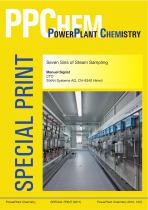
PPCHEM SPECIAL PRINT POWERPLANT CHEMISTRY PowerPlant Chemistry Seven Sins of Steam Sampling Manuel Sigrist CTO SWAN Systeme AG, CH-8340 Hinwil
Open the catalog to page 1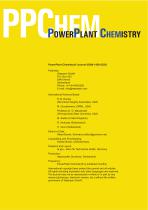
PPCHEM Editorial POWERPLANT CHEMISTRY PowerPlant Chemistry® Journal (ISSN 1438-5325) Publisher: Waesseri GmbH P.O. Box 433 8340 Hinwil Switzerland Phone: +41-44-9402300 E-mail: info@waesseri.com International Advisory Board: R. B. Dooley (Structural Integrity Associates, USA) M. Gruszkiewicz (ORNL, USA) Professor D. D. Macdonald (Pennsylvania State University, USA) M. Sadler (United Kingdom) R. Svoboda (Switzerland) H. Venz (Switzerland) Editor-in-Chief: Albert Bursik, Germany (editor@ppchem.net) Copyediting and Proofreading: Kirsten Brock, USA/Germany Graphics and Layout: te.gra – Büro für...
Open the catalog to page 2
Seven Sins of Steam Sampling Seven Sins of Steam Sampling Manuel Sigrist ABSTRACT Over the past 20 years the main components of power plants such as gas turbines, steam turbines, boilers, and plant control systems have been continuously improved. Strangely, during the same period an auxiliary system with interfaces to several of these main components has hardly seen any changes: the steam/water sampling and analysis system (SWAS). For engineering, procurement, and construction contractors and boiler manufacturers, it is still common practice to specify designs which are out of date. Neither...
Open the catalog to page 3
Isolation/ line blowdown Seven Sins of Steam Sampling Temperature protection Pressure and flow regulation Sample distribution Flow cell and sensor/ measurement device Signal conversion/ transmitter Figure 1: Functional elements of a SWAS, from sample conditioning to distributed control system (DCS) signal exchange. a separation between a wet "sensor part" and a dry transmitter. In practice sodium and silica analyzers are often integrated in the so-called dry rack. This is dangerous as it means routing sample tubing (sometimes flexible tubing!) and an extra drain inside an electric cabinet....
Open the catalog to page 4
Seven Sins of Steam Sampling Temperature Protection: Guideline to Minimizing Operator Safety Example 1 Most samples analyzed in a SWAS will require cooling (typically 20–40 kW cooling power per sample line). In case of failure of the cooling, it is essential to stop the sample flow before it reaches instrumentation or a grab sample where a hot sample could damage equipment or injure operators. One would think that temperature protection is considered an important safety feature. The reality shows many design concepts with severe compromises to operator safety. The OEM responsible for the...
Open the catalog to page 5
Seven Sins of Steam Sampling The downsides of exaggerated line and instrument sharing solutions are often overlooked: Main condensate – There is a major risk of incorrect allocation of measurement to sample line, as the manual valves' positions cannot be remotely checked. – The corresponding pipe routings are often difficult to follow and confusing, thus increasing the risk of error, especially if the system is no longer run by experienced commissioning technicians. – The quality of certain measurements can be severely impaired: for example, an oxygen measurement at the µg · kg–1 level will...
Open the catalog to page 6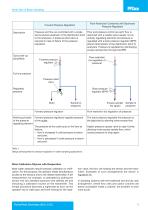
Seven Sins of Steam Sampling Flow Restriction Combined with Backward Pressure Regulation Forward Pressure Regulation Description Typical set-up (simplified) Pressure and flow are controlled with a single device placed upstream of the distribution point to the analyzers. A pressure relief valve is required in case of failure of the pressure regulation. Flow and pressure control are split: flow is restricted with a needle valve (usually not an actively regulating element) and pressure is regulated with a back pressure regulator (BPR) placed downstream of the distribution point to analyzers....
Open the catalog to page 7
Seven Sins of Steam Sampling Flow cells and transmitters in separate locations. Random arrangement of flow cells and transmitters. Figure 11: Figure 10: pH sensor blocked by cation column. The alternative: the transmitter, instrument flow regulating valve, flow cell and sensor of a given measurement must be grouped and arranged consistently. This calls for a modular instrument design (Figure 11). The SWAN Monitor concept is one way to realize this requirement and it offers the following advantages: Dual-channel monitor for specific and acid conductivity (a), oxygen monitor (b), and pH...
Open the catalog to page 8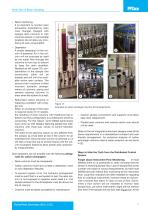
Seven Sins of Steam Sampling – Resin monitoring It is important to monitor resin exhaustion (indicated by resin color change). Designs with opaque resin columns or with columns placed in inaccessible locations do not allow any monitoring of resin consumption. – Deaeration A proper deaeration of the column is essential. Air in the column will not evacuate by itself as the water flow through the columns is from top to bottom to keep the resin stratified. Residual air will cause CO2 contamination of the sample (the conductivity value will be biased) and will limit the available active resin...
Open the catalog to page 9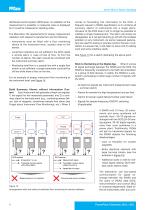
Seven Sins of Steam Sampling distributed control system (DCS) level, no validation of the measurement is possible: a measured value is displayed but it could be measured in standing water. The alternative: the requirements for proper measurement validation with respect to sample flow are the following: - Instruments must be fitted with a flow monitoring device at the instrument level, located close to the - Local flow indicators are not sufficient: the DCS needs a remote alarm in case of loss of flow. To limit the number of alarms, this alarm should be combined with the instrument summary...
Open the catalog to page 10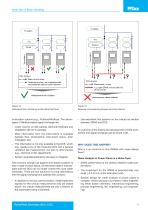
Seven Sins of Steam Sampling -----^ Tra nsm 1tET sjmma "y ala "m combined with cne sample flaw alarm FD" each irstrumert Instrument flow monitoring at the instrument level. ^^^^^^ 1 yiiAipsd SWAS summary alarm fui Measurements without validatan Example of excessively grouped summary alarms. munication options (e.g., Profibus/Modbus). The advan- tages of fieldbus-based signal exchange are: - Lower cost for on-site cabling, electrical hardware and - More information from the instruments is available (sample flow, temperature, instrument status, error - This information is not only available...
Open the catalog to page 11All Swan Analytical Instruments catalogs and technical brochures
-
AMI ISE Universal
2 Pages
-
AMI Hydrazine
2 Pages
-
AMI Codes-II TC
2 Pages
-
AMI Codes-II
2 Pages
-
AMI CACE
2 Pages
-
AMI pH/Redox
2 Pages
-
An Introduction for Non-Chemists
19 Pages
-
Pautbac II
2 Pages
-
Opal
2 Pages
-
TOC Evolution VUV
2 Pages
-
Topaz Analyzer
2 Pages
-
Automated Quality Assurance
6 Pages






















